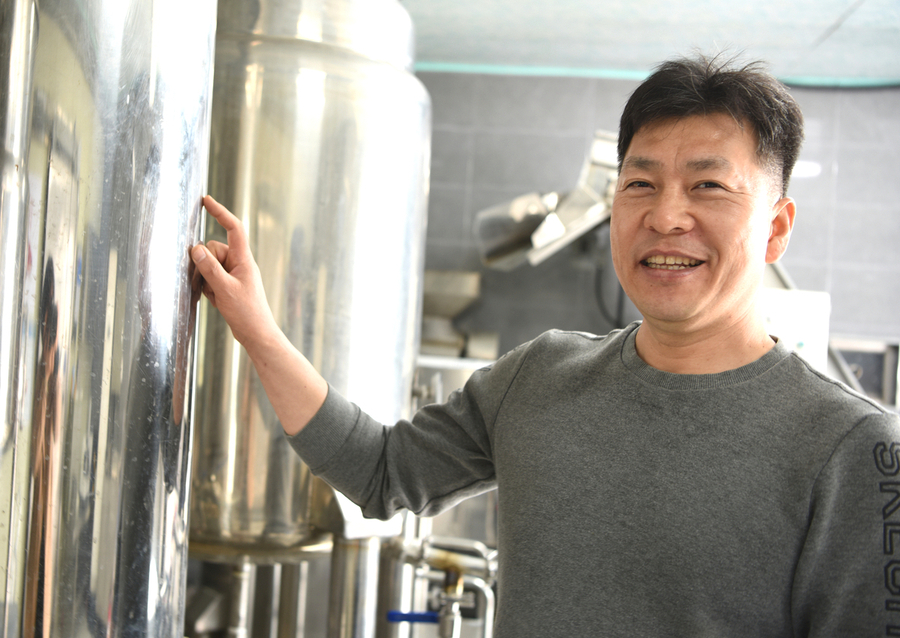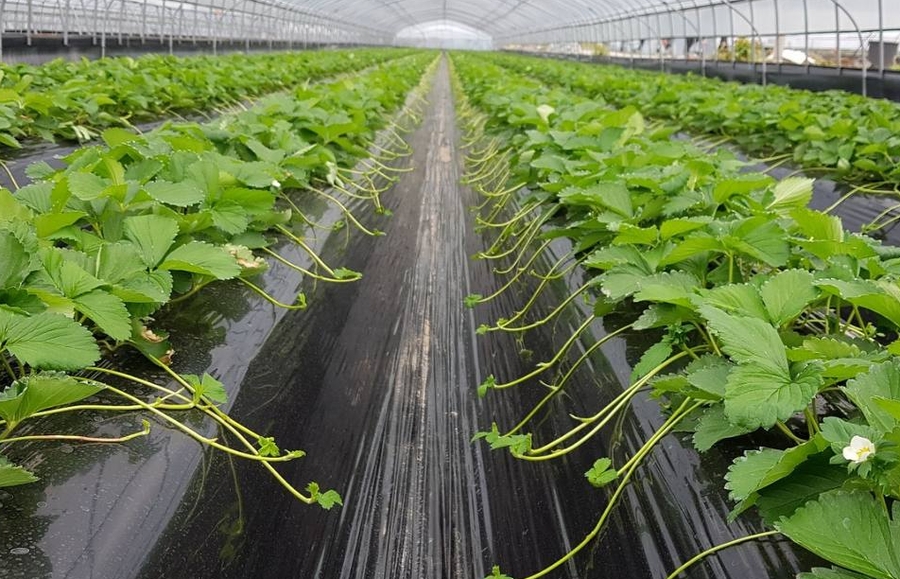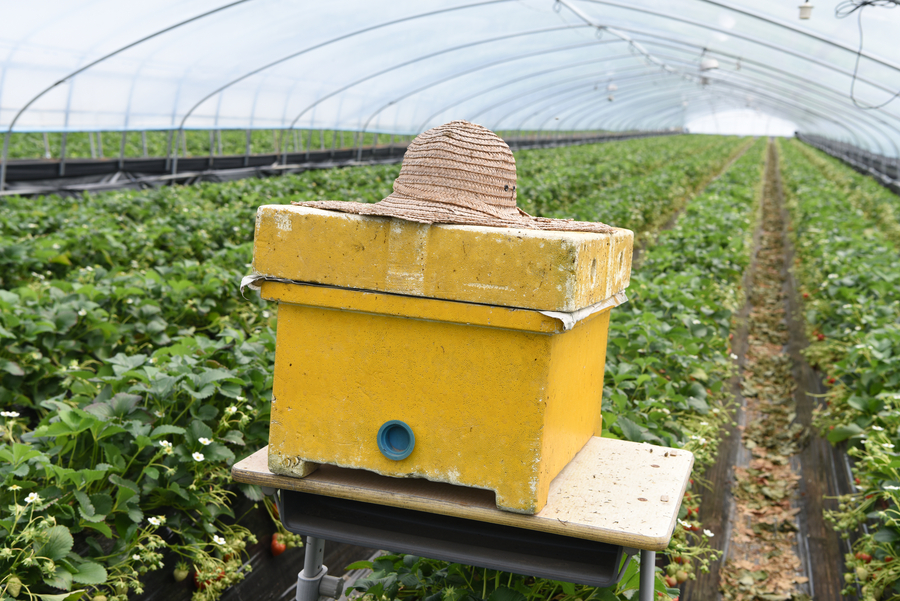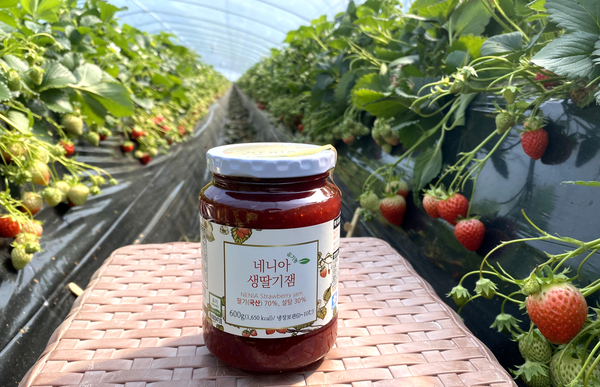Webzine
Climate Crisis Is Unavoidable: “The strawberry leaves are all scorched."
2025.07.21Life begins in the soil, and when we say “the soil is
alive,” we mean that countless living organisms are constantly moving within
it.
Nenia is committed to creating and distributing eco-friendly food that stays as
close to nature as possible. We meet with farmers and producers to share
stories of soil, seeds, and hard-earned harvests.
For the first in this series, we visited Anrim
Strawberry Farm, where organic strawberries are
grown.
— Editorial Team, Nenia Web Magazine
[Nenia’s “Fresh Strawberry Jam” Producer Interview — Farmer Baek Dong-Min of Anrim Strawberry Farm]
In Goryeong County, North Gyeongsang Province—land of the ancient Daegaya Kingdom—lies a cluster of ancient tombs now registered as a UNESCO World Heritage site. But in Goryeong, there’s another local symbol you can’t miss: strawberries.
Right off the Goryeong IC exit, rows of roadside tents selling strawberries stretch alongside the road. Farmer Baek Dong-Min, now 50, has been growing strawberries in his hometown of Ssangnim-myeon, Goryeong County, for 25 years. He started farming back in 2000, right after graduating college at the age of 25.
Baek not only sells fresh strawberries, but also makes Nenia Fresh Strawberry Jam, packed with vitamin C. We sat down with Baek Dong-Min, head of Anrim Strawberry Farm, to learn more about his journey as an organic strawberry farmer.

▲ Farmer Baek Dong-Min growing strawberries in Goryeong, North Gyeongsang Province (Photo = Nenia)
Is a strawberry plant an annual or a perennial?
In the wild, strawberries are perennials. But in cultivation, they’re treated
as annuals. The full farming cycle for strawberries spans about 14
months. What does that mean?
Strawberries grown in greenhouses are usually harvested from November through April or May. Right around mid-March—peak harvest time—farmers begin preparing “nursery plants” for the next season. That means they’re harvesting on one side of the farm while starting new plant propagation on the other, making two months of overlap.

Strawberry propagation isn’t done with seeds—it’s done by planting runners or shoots, which makes it a labor-intensive task. A runner is a long, slender horizontal stem that grows from the parent plant along the surface of the soil. At various points of nodes, it sprouts roots and shoots, forming new plantlets. The period during which these runners are cut and cultivated into seedlings is called the ‘nursery phase.’ March to April is not only peak strawberry-picking season but also the time when propagation is in full swing. It’s the most demanding period for farmers.
The strawberry seedlings grow in a separate nursery facility. Meanwhile, in the main greenhouse where strawberries have just been harvested, the plants are left to wither, and by early June, the soil is tilled. Then, rice is planted temporarily. As the rice grows, it is tilled back into the soil by mid-August, turning it into a natural compost. After that, farmers shape ridges and furrows in the soil and transplant the nursery-grown strawberry seedlings in September—a process called “jeongsik” (transplanting).
Once the seedlings are in the ground, the challenge becomes helping them take root and grow well. But with rising temperatures, diseases that weren’t visible during the nursery stage often appear after transplanting. Baek explains, “We get hit with a lot of diseases. A lot of farmers really struggle because of it.” Some farmers even end up plowing under their entire strawberry field and starting over. That’s why it’s crucial to have extra seedlings on hand.
If you had to buy enough seedlings to plant eight
greenhouses, it could cost up to 40
million won (approx. $30,000 USD). Managing
seedlings is said to be even harder than the harvest itself.
Climate Crisis Is Unavoidable: “The strawberry leaves are all scorched.”
Farmer Baek has experienced failure in strawberry farming about five times - mainly due to diseases that emerged after transplanting the seedlings. Strawberries are highly susceptible to diseases like anthracnose and blight. When those strike, they can wipe out an entire crop. They’re also vulnerable to powdery mildew, aphids, and leaf beetles. While conventional farming may resort to chemical pesticides, organic farmers like Baek must rely on eco-friendly agricultural inputs. In particular, aphids and mites cause severe issues by sucking the sap from the strawberry plants.
“It keeps getting harder,” says Baek.
“During the nursery stage, temperatures have been rising too much. Sometimes
the seedlings seem
healthy, but they’re actually carrying hidden infections that show up after
transplanting. It’s not just me—other farmers around here are saying the same
thing. Growing seedlings has gotten much more difficult.”
Baek recalls a shock from last year (2024):
“It was the first time I’d ever seen this happen—all the strawberry leaves burned.”
He had transplanted his seedlings around September 10, but the leaves scorched soon after.
“My heart sank,” he says.
Thankfully, new leaves sprouted from the center, and the plants recovered.
Still, Baek worries that farming will only become more
difficult in
the face of worsening climate conditions.
After transplanting, farmers lay mulch film (plastic sheeting) over the soil ridges to prevent weeds. Most crops are planted after mulching, but with strawberries, covering the soil before transplanting can scorch the seedlings. So instead, they lay the film after planting and then pull each strawberry plant through holes in the plastic— a painstaking and time-consuming task.
By the end of November, about three months after transplanting, the strawberries are ready
for harvest. But more challenges awaited. This season, Baek’s first harvest
didn’t begin until early January—two months later
than usual. He
says it was because the flower bud differentiation didn’t occur properly due to abnormal temperatures.
In simpler terms: The strawberry flowers were late to bloom.

▲ Once strawberry flowers bloom, honeybees pollinate them to form fruit. The yellow wooden boxes in the photo are beehives. (Photo = Nenia)
Located in the southern region of Korea, Goryeong enjoys relatively warm weather. While Baek has greenhouse facilities, he doesn’t rely on fossil-fuel-based heating. Instead, he uses a double-layered vinyl greenhouse system. Groundwater flows between the layers of plastic, and the lukewarm water helps regulate the temperature inside the greenhouse naturally.
No Boiling, Just Simmering: “Fresh Strawberry Jam”
Viscosity that can't be measured—timing is everything!
The jam-making equipment at Anrim Strawberry Farm was developed by Baek’s late father. This unique setup allows Baek to make jam without boiling the strawberries. While most low-temperature jam methods still cook at 60–80°C, Baek’s “fresh strawberry jam” is made at just 40°C. The secret lies in the equipment’s carefully engineered design, but he keeps the exact details under wraps as a trade secret.
The most difficult part of jam-making is getting the concentration timing just right. Even with tools like refractometers and moisture meters, it’s impossible to precisely measure the viscosity—how thick the jam is becoming. That’s because strawberries vary in moisture content depending on the weather—hot or cold, humid or dry. There’s no fixed formula or rule. Baek has had several failed batches of jam over the years—some too runny, others too thick. Through those experiences, he learned to rely on the feel in his fingertips to judge the exact moment to stop the concentration process.
If the jam is over-concentrated, it hardens—and there's no saving it. Even adding water won’t restore the texture. In such cases, an entire pot—about 200 kilograms—must be discarded. This is why timing and precision are especially critical for Nenia’s Fresh Strawberry Jam, which contains a high ratio of fruit: 70% organic strawberries and 30% organic sugar. While a higher sugar content extends shelf life, Baek’s jam uses minimal sugar to keep the strawberry flavor front and center. To make it shelf-stable without any additives, he must hit the perfect viscosity. Nenia’s Fresh Strawberry Jam contains only two ingredients: organic strawberries and organic sugar. No preservatives. No artificial colors. No gelling agents like pectin.

▲ Nenia’s Organic Fresh Strawberry Jam, made by Anrim Strawberry Farm (Photo = Nenia)
The Charm of Nenia’s Fresh Strawberry Jam: Color and Flavor That Stand Out
After such a meticulous and delicate
process, Nenia’s Fresh Strawberry Jam boasts a bright, vivid strawberry
color—quite different from regular jam that’s been boiled.
Each 600g jar of Nenia jam contains about 1 kilogram of fresh organic
strawberries. Because the strawberries are picked at peak ripeness and used
immediately, the flavor is on an entirely different level compared to jam made
from frozen fruit.
Baek Dong-Min explains: “Since it’s not boiled, the color stays vibrant, and more importantly, the vitamin C remains intact. Freezing strawberries damages their structure. You need to use fresh fruit to get the true flavor.” No boiling. No freezing. Just the pure essence of fresh strawberries in a jar—that’s what Nenia Fresh Strawberry Jam is all about.
Farmer Baek’s Concerns
When it comes to strawberry farming, Baek says the most critical moment is right after transplanting—when it’s uncertain whether the seedlings will survive. After that, the next biggest challenge is finding labor. These days, even hiring migrant workers has become increasingly difficult. He adds: “What really troubles me is that farming doesn't pay as much as people think.” Operating costs—from maintaining greenhouses to purchasing supplies—add up fast. As a farmer, he has no pension, no retirement fund. Yet Baek continues farming organically, determined to restore life to the soil. Just as he’s committed to nurturing the land, he hopes urban consumers will stand with farmers—supporting Korean agriculture through their choices and care.
— Nenia Web Magazine Editorial Team








